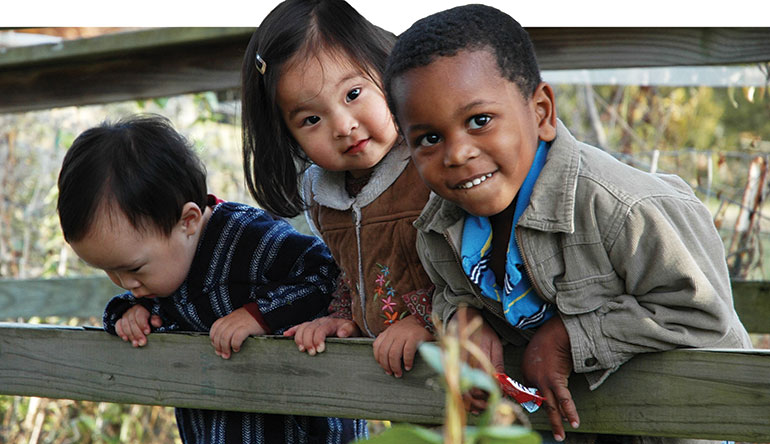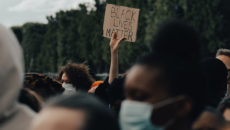Parents who adopt transracially may wonder, “How do I prepare my child for racism without making her oversensitive to it? By talking about race, are we going to poison her feelings toward white people?” The truth is, racism exists and your children will experience it, in varying forms, whether you talk about it or not.
The question for you is, are you prepared to hold up your side of the conversation, giving your children the tools to handle racism now and to understand how it will affect them throughout their lives? Talking about racism is admittedly difficult in our society. Even the word “race” carries a taboo, as though mentioning it is itself racist.
In the San Francisco Bay Area, where we have done most of our work, there is a prevailing philosophy that “colorblindness” is the solution. But striking a “colorblind” attitude may lead your children to feel that certain aspects of their identities are invisible, and won’t have any effect on the way they’re perceived by society at large.
Parents who plan to discuss race and racism with their children wonder when to begin the dialogue, and what their children need to hear at each age. We recommend starting before your children can engage in discussion, and offer advice for talking about race and racism from birth through elementary school.
Ages 0-2
Your children’s pre-verbal years are the time to lay a foundation for future conversations around race, racism, and identity. Be sure that you and the rest of your family know the difference between race, ethnicity, culture, heritage, nationality, and identity. Look for toys, books, and other media that provide visual representations of your child’s ethnic heritage.
Bonds that are formed during the pre-verbal stage are powerful, so make sure your circle includes adults who share your children’s ethnicities and can serve as role models. One way to find them is to get involved with cultural or service organizations that are rooted in your children’s heritages. Not all people of a particular heritage are invested in that heritage, of course, but those involved in such organizations are more likely to be so.
Scenarios: Your pre-verbal toddler touches her skin and looks at yours. You live in a predominantly white community, and your family is already getting the “triangular stare” (that look of confusion that goes from parent to child to parent). Strangers and extended family members are making unintentionally insensitive comments.
Suggestions: It is important to cultivate the community your children will be raised in. To this end, begin a dialogue with family and friends about your feelings on race and racism. Let them know what words are appropriate for describing their relationship to your children and your children’s ethnic heritages, and what racial language you would like them to avoid (for example, if the term “half” is not acceptable to you, you should make that clear).
Encourage your family members to use ethnically or familially appropriate labels (i.e., Halmoni, Yia-yia, Nannu, and so on) to describe their relationship with your child. Display photographs of diverse friends and family members around your home, or compile photos in a laminated book. Most important, keep talking about race and racism, so that you’ll be comfortable discussing the topic.
Ages 3-5
Between the ages of three and five, as children enter day care and preschool, their worlds expand significantly. At this stage, children tend to notice obvious differences: boys versus girls, different skin colors and hair textures.
Scenarios: Your child asks you why you and she do not look the same. She overhears strangers, or even extended family members, asking questions like, “Where did you get that child?” or “What is she?”
Suggestions: In the three-to-five age range, children are beginning to develop the vocabulary and cognitive ability to explore race and racism. While it may seem like a good idea to water down the topic, using current and appropriate vocabulary, such as “biracial,” “multiracial,” “transracially adopted,” and “racism,” will benefit your child in the long-term. The more familiar these terms become, the greater the chance your children will eventually take ownership of the terms that resonate with their identities.
In the course of your conversations, ask your children what they think it means that you and they look different from one another, how they came to realize this, and how they feel about it. Reassure them that it’s OK for family members to look different from one another.
Because questions from strangers often come in your children’s presence, be aware that your reply matters greatly to your children. One mom we know generally responds, “I understand your curiosity, but that question is personal (or inappropriate) and I’m not going to answer it,” and reinforces her refusal by turning away from the questioner. Her approach tells her child that she has a right not to engage with strangers about such personal matters. If it’s a friend or a family member asking the question, share resources, and don’t be shy about correcting their language.
When your children’s day care or preschool year begins, meet with their teachers for an informal and open discussion about what you hope your children will learn about race, ethnicity, and identity. Follow up by providing books, toys, and other media, and offer yourself as a sounding board for ideas about dealing with discrimination in the classroom.
Ages 6-7
At this stage, children will have many of their discussions and experiences concerning race, ethnicity, and racism in the school setting. Be proactive about building a strong, positive relationship with your children’s teachers and school administrators. Get involved with the PTA and make sure there are plans in place to deal with teasing and bullying.
Scenarios: Other children ask your child what he is and why he doesn’t look like you, or they tell your child that families should all look the same. Your child hears racial epithets and racial stereotyping from other children and even other adults—including teachers.
Suggestions: You can’t be present at every conversation and/or incident that touches on race or racism. If you’ve put a strong foundation in place with early talks, however, your children can handle them themselves, and will be more open to discussing these experiences with you after the fact. If your child is the target of a racial epithet or a negative racial incident, talk with him about what happened, affirm his emotional reactions, and discuss ideas for dealing with future incidents. If it is appropriate, involve your child’s teachers.
Let your children know that they have the right to define who they are. Reaffirm that it’s OK for members of a family to look different from one another; your family was deliberately built with people who look different from each other.
Ages 8-10
Kids will be using language that you use at home to talk about race and ethnicity, and will start to identify with certain terms. Even so, they may still be unclear as to what those terms mean. By the late elementary years, children will also have absorbed some of the stereotypes about race—particularly around who is more or less attractive or otherwise “better” than another.
Scenarios: Your child comes home saying, “I think I’m black and Mexican,” or “I’m Filipino and white,” but it is clear he doesn’t really know what those terms mean. Your child may also come to you at some point and deny her race or ethnicity, saying, “I’m not Chinese” or “I’m not black.” Children may also shift identities from day to day because they’re exploring what the words mean, or they don’t yet differentiate between heritage and identity.
Suggestions: Ask your children what they mean when they use racial or ethnic terms. Does a certain word make them feel proud? Uncertain? Loved? As you explore your children’s declarations about race and ethnicity, keep in mind that their understanding of terms is probably different from yours. If a child says, “I’m not Korean,” it might be because someone told him that Korean people eat dogs, and he doesn’t want to identify with eating dogs. In turn, you can share how you feel connected to your family and what the words your children are using mean to you.
Acknowledge that the way you relate to the family may be different from the way your child does. Clarify that heritage and identity are not the same thing. For example, your heritage may be Japanese, Irish, Native American, and African American, but you may primarily identify as Native American.
At this age, role models are crucial. Your guidance and love are as important as ever to your children, but most adoptive parents’ experiences differ vastly from their children’s. In the preteen years, kids need to see their identity reflected in someone who looks like them and who shares a similar background.
Call on the relationships you cultivated when your child was younger, or turn to the growing community of adult transracial adoptees. Many are involved with formal mentorship programs. Summer camps, such as the FUSION program, offer a safe, structured environment in which kids can interact with a diverse group of mixed heritage role models who are making a difference in their communities.
Books are another wonderful way to approach this kind of discussion [see “Reading About Race,” for recommendations].
Continuing the Dialogue
Let your children know that they will encounter both the personal racism of individuals (people who may refuse to touch them or even look at them; people who will choose to befriend or not befriend them, to date or not date them because of racial stereotypes), and the structural racism inherent in our society (she’ll find fewer teachers of color the higher up the education hierarchy she goes; he may face assumptions that he won jobs or acceptance at college because of “affirmative action” rather than merit).
Personal racism is easier for young children to comprehend, so you may try role-playing with your child. For example, call your child “weird” or say something about her appearance being strange. Have her act out responses. She might decide to ignore the comment and tell the teacher, or to say something like, “I’m not weird. I’m proud of who I am!” or “Everyone is weird, and that makes the world more interesting!”
If your child reports a racist incident to you, don’t tell him that he imagined it or is being oversensitive. As you discuss it, however, focus on how it made your child feel rather than on the intent of the perpetrator. Let your children know that your home is a safe space to talk about these issues, even if you must put aside your own discomfort with other people’s racism.
What if your children are responsible for incidents of racism? We have encountered situations where children of color, particularly if they are surrounded by white peers and teachers, develop a self-hatred that they project onto other children (or adults) of color. If you’re alerted to such an incident, focus on letting your children talk about the feelings they may have about themselves, about other people who look like them, and about people who do not look like them. Keep calm and try not to level accusations—your child may be confused about some of the words she used, or, even if she is perfectly clear, there may be something else going on that you need to get her talking about.
Remember that, as the years go by, your children’s identity formation will increasingly become a personal journey. By setting clear boundaries with strangers and extended family members, by building strong connections in a mixed-heritage and transracial adoptee community, by providing relationships with role models of color, and by being honest and forthcoming about your own feelings about race and racism, you will give your children the tools and confidence to navigate the discovery of their identities.



